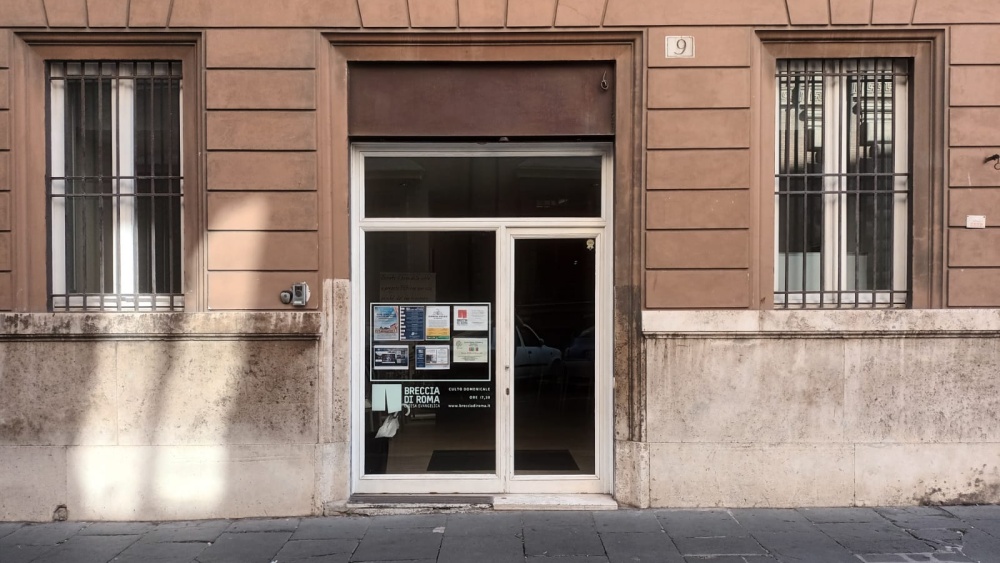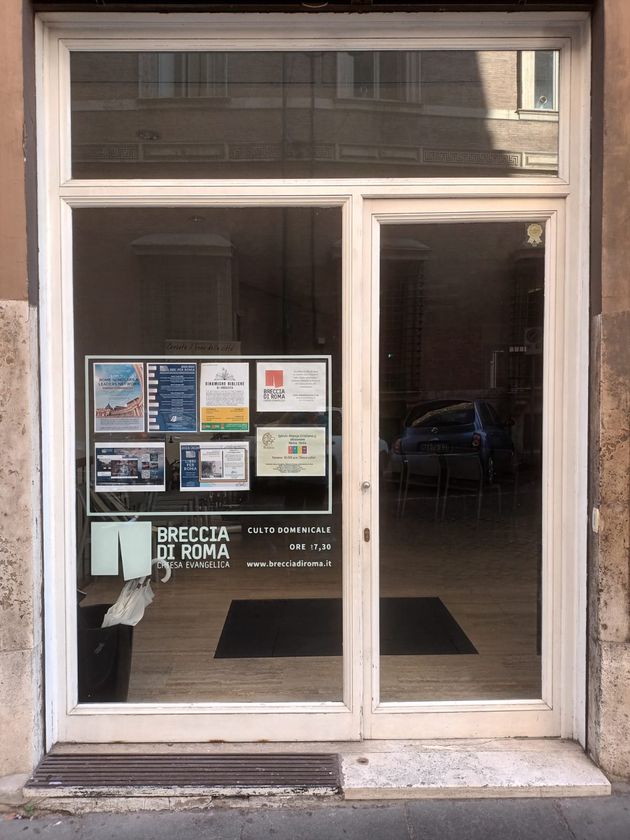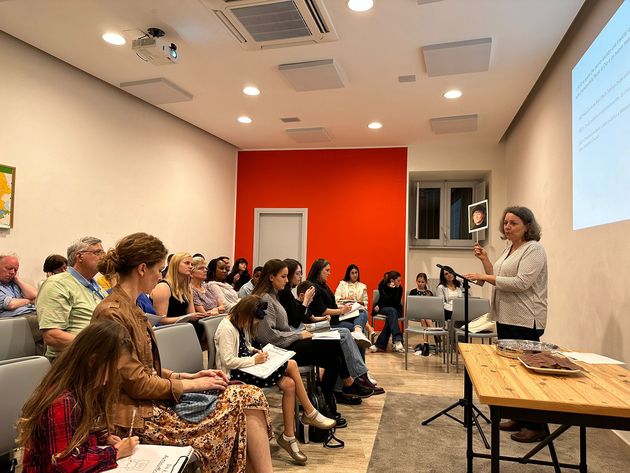The Breccia di Roma has paid €12,000 in legal fees to defend their right to a have a recognised worship place. “As a minority, you have to work two to three times harder to access what other groups have more easily”.
 Entrance of the Evangelical church Breccia di Roma. / All photos: Breccia di Roma.
Entrance of the Evangelical church Breccia di Roma. / All photos: Breccia di Roma.
Perhaps you think the persecution of Christians in the Western world is a matter of the past. There's no way Christians are still persecuted in the West today, right?
Wrong. Persecution (in the form of harassment) is alive and well for the pastor of the small church Breccia di Roma and other Evangelical churches in Italy.
The evangelical churches in the Mediterranean country desperately need the freedom of religion promised in the Italian constitution. But evangelical Christians in Italy face various forms of persistent harassment, and something has to change.
In 2016, Pastor Leonardo De Chirico's church, Breccia di Roma, wanted to purchase an old storefront in the historic district of Rome and convert it to be the meeting place for the church.
For Leonardo, this request is because Roman Catholicism "is ingrained in the bureaucracy; it is embedded in the culture of the administration."
Fortunately, after finding non-bank financing, the congregation was able to purchase the building and convert it into a building for Breccia di Roma.

Leonardo's plan for this conversion was simple because Protestant evangelical places of worship have always had a simple purpose: to be a multifunctional space used for various purposes.
After purchasing the building, Breccia di Roma had to apply to be rezoned from a shop to a church building because churches are tax-exempt in Italy.
[destacate]A banker said he would need to get the signature of the bishop of Rome to get a loan to purchase the building[/destacate] Normally, this is a fairly simple process, but the pastor eventually learned this would not be the case for his church.
First, he went to the Office of Preservation and was granted initial permission. He then went to the local city council, which also gave its approval. Then, the church had to pay €6,000 for the change of their tax-exempt status to take place.
All of this was standard, and the building's re-designation as a church should have been final after Breccia di Roma paid the fee.
But then, the national tax agency decided to visit the church.
The inspector from the agency took a look around Breccia di Roma, asked questions, and took pictures. Leonardo eventually received notification that his church would be taken to court: the agency did not want to permit the use of this building for a church. They were concerned that there was no structural change to the building, and it did not fit their idea of a church building (a standard Roman Catholic church building).
They argued that Breccia di Roma lacked the “intrinsic characteristics of religious buildings", with icons, candles, altars, statues, etc. In response, Leonardo explained:
“Protestant worship doesn't use images, statues, or the altar. And since we are a Protestant church, it is part of our convictions that we don't need, we don't want, places of worship characterized by the presence of altars, pictures, images, and so on”.

So, the church had to go through the expensive process of hiring a lawyer and defending its existence as a church in court. In the end, the judges sided with Leonardo's church and rejected the charge of the tax department.
Breccia di Roma thought the issue was settled until they heard from the tax department again six months later. This time, the tax department brought the case to the higher regional court. The tax authority used the same argument as before, which is that the church had no significant structural change and did not look like a church with (Roman Catholic) religious worship.
Also, the tax authority took a new tactic, they shared pictures of what they believed religious buildings should look like: large, impressive, ornate, historic structures.
So, Leonardo's church had to pay again for an expensive lawyer to defend their existence in a democracy with supposed freedom of religion.
Breccia di Roma's lawyer shared over 20 pictures of places of worship in Rome that looked similar to their building, such as various Muslim prayer rooms, Jewish synagogues, and small Roman Catholic churches that all had permission to serve as places of worship in Rome.
Leonardo explains his church's legal argument:
“As far as Muslim, Jewish, and Catholic places of worship, not all are monumental, impressive, historic, or large, and many of them look like our own place of worship and are zoned as religious buildings. And yet they are tax exempt”.
These photos demonstrated that rezoning had not been a problem for Muslim, Jewish, and Roman Catholic buildings of worship that looked similar to Breccia di Roma's simple storefront building.
[destacate]The national tax agency argued that the church lacked the “intrinsic characteristics of religious buildings”, with icons, candles, altars, statues, etc[/destacate]For the second time, the court sided with the church. They rejected the tax department with the same argument as before. Leonardo summarizes the court's response:
“First, the fact that they didn't alter the property's structure doesn't mean it can't be used for religious purposes. Second, it is well known that Protestant places of worship are characterized by simplicity, multifunctionality, and lack of images, pictures, etc”.
Leonardo's church was seemingly in the clear after winning the approval of two court hearings.
Then on May 26, 2023, Breccia di Roma was notified that the tax authority had appealed to Italy's Supreme Court in its legal attack on Leonardo's small church.
The tax authority again uses the same argument. Breccia di Roma does not look like their concept of a church (a Roman Catholic church), and therefore, it should be taxed.
So, Leonardo's church has rehired their lawyer, and the story is still unfolding. This five-year bureaucratic harassment of a small Evangelical church is because they do not practice Roman Catholic worship, including sacraments and its visual devices.
He also believes things are specifically challenging for his church because they are in historic Rome, and there is more vigorous opposition to evangelical churches in Rome.
So, for now, Breccia di Roma will continue to battle for the right to be a church and the freedom of religion that the Italian constitution promised, but the Italian government has not delivered.

Unfortunately, this issue goes far beyond the walls of Breccia di Roma. Evangelical churches across Italy are being harassed and denied the religious freedom the Italian constitution promises.
The World Evangelical Alliance and the Italian Evangelical Alliance worked together to compile a shocking report highlighting Italy's discrimination against religious minorities clarifying several vital issues.
First, Italy's constitution in 1948 promised religious freedom, but in the last 75 years, the country has not yet enacted a religious freedom act that clarifies what this freedom means.
The report documents how the Italian legal system's lack of a specific religious freedom act “caused and is causing discriminations to the religious minorities”. The report clarified that this problem was identified long ago.
“Almost 60 years ago, the protestant historian and jurist Giorgio Peyrot, ended his report on Religious Liberty in Italy," asking for “a final and satisfactory solution of the impending problem of the relations between the State and the non-Catholic churches”.
Seventy-five years later, all of Italy's religious minorities are still waiting and hoping for the freedom of religion promised in the Italian constitution.
Second, the report shared that one major difficulty for religious minorities is the unfair nature of Italian zoning regulations, which we see with Leonardo's church because they have had to pay nearly €20,000 for rezoning and legal fees.
“The issue remains that both opening new places of worship and keeping existing ones open remains increasingly difficult due to the unfair nature of the zoning regulations avowedly created to impede the opening of new places of worship”.
Third, the report explains the difficulties small churches face when the government only specifically designates religious leaders when they have at least 500 members in their church. “The process of acquiring recognition by the State, as provided in Article 8 of our Constitution, has been practically stalled”. According to this requirement, Jesus and his 12 disciples would not have qualified as religious leaders.
This report clarifies that harassment occurs against all Italian religious minorities, but mainly impacts evangelicals.
Another example of this harassment is the closure of Punto Luce church building near Milan, north of Italy.
A little background is necessary. In 2005, the Lombardy Region established a regional law that “aimed at hindering the opening of new places of worship for confessions other than the majority one (Roman Catholic)”.
Other regions across Italy established similar legislative measures, which were arbitrary and “essentially discriminatory”. The law led to the closure of dozens of Evangelical churches, most of which didn't have the financial resources to fight the Italian bureaucracy.
In March 2015, the municipality of San Giuliano Milanese (on the outskirts of Milan) published a notice regarding the requirements for places of worship in the city.
Two months later, Punto Luce (an evangelical church) followed the city's directive and requested a location from the municipality as detailed by the city.
Then, they waited for a response from the city for a year and a half. In October 2016, the church moved forward to rent a place suitable for worship.
Punto Luce finally heard back from the city on March 19, 2019 (two and ½ years later), that the city was investigating their rented location of a place to worship, and the city issued an order for them to close their church in June 2019.
By September 2019, Punto Luce appealed this decision, and the Italian Evangelical Alliance stepped in to support their appeal.
Finally on January 23, 2020, the Council of State approved Punto Luce's request, and the church was allowed to return to its premises. The final judgment rejected San Giuliano Milanese’s actions and recognized “various abuses in the behavior of the municipality”.
We see the same pattern with Punto Luce and Breccia di Roma as local or national bureaucrats harass small evangelical churches over many years with expensive legal challenges and requirements.
Many small churches without financial resources or contacts cannot resist the persistent bureaucratic harassment.
When will Italians actually experience the religious freedom that their constitution grants but that the State fails to deliver fully?
Rachel Wierenga holds a Bachelor's of Science in Integrated Ministry Studies degree (The Moody Bible Institute), is working towards her Master of Divinity degree (Denver Seminary), and is the Grant Writer for the Forum of Christian Leaders.

Las opiniones vertidas por nuestros colaboradores se realizan a nivel personal, pudiendo coincidir o no con la postura de la dirección de Protestante Digital.
Si quieres comentar o